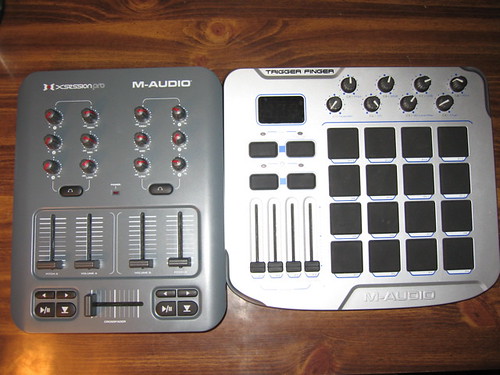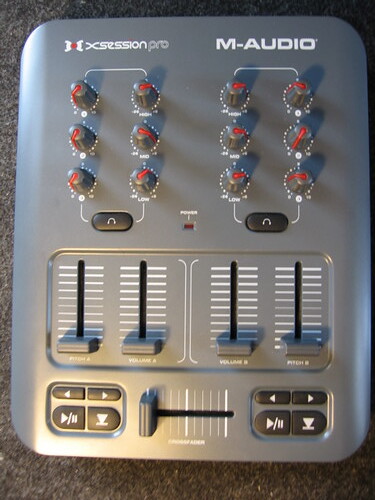Eric Richmond is a “deep house DJ who was looking for a dedicated MIDI controller for ‘standard’ 2 channel mixing.” Amidst all the buzz about M-Audio’s new X-Session Pro (XSP) DJ-style controller, even before it had been released, it’s been hard to get solid information on how the gear works in the real world. Eric took the plunge early and brings us some hands-on testing from the DJ booth.
The XSP is a new MIDI controller by M-Audio set to replace the older “X-Session” MIDI device, and attempts to replicate the standard 2-4 channel audio mixers with which most of us are familiar.
The device feels sturdy, better than my M-Audio Oxygen 8, and on par with my M-Audio Trigger Finger. One nice touch is the crossfader slider is much less resistant then the volume/pitch sliders, as you’d expect. The EQ/aux knobs are tall and spread out apart, so it’s very easy to tweak just the ones you want. The only real complaint I might have is that the top piece of plastic feels a little “cheap”, and the knobs and sliders stick up so high that if you pack it in a bag as-is, you need to take care that nothing would come crushing down on top of it. However, for $100 retail, these are minor complaints. [Ed: I will say, such is the case with the protruding controls on most controllers. -PK]
Choosing MIDI Assignments
Getting the XSP to work in Live 5.2.2 (my DJ tool of choice) was a snap. Just load up Live, press the “MIDI” button, and assign away. No problems/gotchas here. My first test was going to just be a standard 2-channel DJ gig, so I assigned things in a pretty standard way. The EQ knobs went to each channel respectively, and two of the aux knobs went to aux send levels for each channel (where I had various effects). Volume sliders, crossfader, and the start and stop buttons were standard as well.
Instead of using the “cue” buttons for cueing, I decided to use the “pitch” sliders as independent cue volumes for each channel. This way, I could easily mix the two channels in my headphones, independently of how the individual volume sliders were set up. With the cue buttons, I set one to toggle “loop on/off” for the selected clip in live. I mapped the sets of REW/FF buttons to moving around the session view in Live. This way, the only time I had to touch the mouse was when I was dragging in a clip. Once I did that, I could use the REW/FF buttons to navigate session view to the correct clip and use the start/stop buttons to fire them off.
This setup worked extremely well: I had only used the XSP for a few hours before the gig, but since it felt like a standard mixer, it was obvious what was doing what, and I didn’t make any mistakes. If anything, it was pretty liberating rarely having to look at the computer screen — there was none of the dreaded “he’s checking e-mail” syndrome that people complain about with “digital DJs”.
Comparisons

Lastly, I know we’ve all probably tested a ton of devices in searching for MIDI controller nirvana. In my particular quest to find the perfect “standard DJ midi mixer” I looked into and have had physical experience with:
- Kontrol DJ – A good friend of mine who DJs in Traktor uses this, and it’s an AMAZING controller, and is perfect for Traktor. Unfortunately, it does not map to Ableton Live that well.
- Faderfox LV2, DJ2, DX2, LX2 devices – I know someone who has a couple of these, and they’re amazing, but the problem was I couldn’t find a combo of any two of them that gave me “everything” I wanted. Plus, they’re quite pricey, and at that price point, I would want things to be perfect.
- M-Audio Trigger Finger – Before getting the XSP, I was using a TF as my main mixing controller. While it actually worked OK (I could use pads as EQ kill switches, which was sweet), I was leery of using other banks for one-shots and fx. Since the TF does not tell you which bank is loaded in the LCD display, I was fearful that I’d be in the wrong bank, trying to do the wrong thing.
Conclusions

So, what’s the verdict? In my case, it’s EXACTLY what I was looking for. Now when I have “standard” DJ gigs, I have a perfect controller just for that task. No more making a wacky Trigger Finger bank to try and fake it. The only thing I would have liked to have seen were kill switches for the EQs, but again, for $100, it’s hard to complain.
I know people will say “but the power of Live is being freed from two channels; I want to mix 13 clips at once and I only want to use one end-all-be-all device while doing it!” If this is the case, then this is not the device for you. With the XSP able to handle my “standard” DJ gigs, I can free up my Trigger Finger to be a wacky FX board, as well as programming a couple of banks for triggering one-shots and loops.
Anyway, hope this review helps, and if you guys have any further questions about the device, feel free to email me @ eric DOT richmond AT gmail DOT com
Ed: If anyone else has hands-on experience with the X-Session Pro, we’ll post that, too; I’m still interested in what non-traditional DJs, electronic musicians, and VJs might do with this device! -PK
Related:
M-Audio Releases X-Session Pro DJ Controller, $129
Cheap, Functional, Quirky: BCD2000 Mix & Scratch MIDI Controller Review, Part I
Faderfox Controllers for Live, DJing: US Distribution, Upcoming Models
Faders, Knobs, Crossfader: New VMX Control Surface